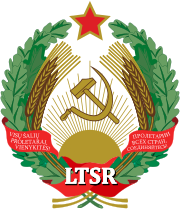The party was working illegally from 1920 until 1940. Although the party was illegal, some of its members took part in the 1922 Lithuanian parliamentary election under title "Workers Groups". It managed to gather 5.0 per cent of vote (or around 40,000 votes) and elect five members. Due to political instability, Seimas was dissolved and new elections took place in 1923. In these elections, the party lost half of its support.
In 1940 the party amalgamated with the Communist Party of the Soviet Union (Bolsheviks) (CPSU). By the time of the formation of the Lithuanian SSR, the Communist Party of Lithuania (LKP) was headed by Antanas Sniečkus. In 1940, the LKP merged into the CPSU(b). The territorial organisation of the party in Lithuania was called Communist Party of Lithuania (bolshevik) (LKP (b)). In the Lithuanian territorial organisation, the first secretary of the Central Committee of the party (always a Lithuanian) was de facto ruler of the country. The second secretary for the most of Soviet era was a Moscow-appointed Russian. In 1952 the name of the old Lithuanian party, LKP, was re-adopted.
On 24 December 1989,[1] during mass protests of the Singing Revolution against the Soviet Union in Lithuania, the party declared itself independent from the Communist Party of the Soviet Union. By 1990, the main body of the CPL reorganized as the Democratic Labour Party of Lithuania, which in turn by 2001 merged with Social Democratic Party of Lithuania under the latter's name; but with leadership dominated by ex-communists.
A small portion of the party remained loyal to the CPSU, and reorganized as the Communist Party of Lithuania ('on platform of Communist Party of the Soviet Union') under the leadership of Mykolas Burokevičius after the "traditional" party declared independence from its Soviet Union counterpart. The party played a major role in the January 1991 Events in Lithuania.
The Communist Party of Lithuania was eventually banned on 23 August 1991.[2]


